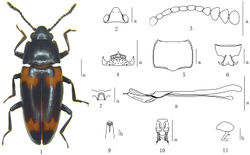Episcapha lushuiensis
| Notice: | This page is derived from the original publication listed below, whose author(s) should always be credited. Further contributors may edit and improve the content of this page and, consequently, need to be credited as well (see page history). Any assessment of factual correctness requires a careful review of the original article as well as of subsequent contributions.
If you are uncertain whether your planned contribution is correct or not, we suggest that you use the associated discussion page instead of editing the page directly. This page should be cited as follows (rationale):
Citation formats to copy and paste
BibTeX: @article{Li2012ZooKeys203, RIS/ Endnote: TY - JOUR Wikipedia/ Citizendium: <ref name="Li2012ZooKeys203">{{Citation See also the citation download page at the journal. |
Ordo: Coleoptera
Familia: Erotylidae
Genus: Episcapha
Name
Episcapha lushuiensis Li & Ren, 2012 sp. n. – Wikispecies link – Pensoft Profile
Type material
Holotype. male, CHINA: Yunnan Province, Lushui County, 25.9667°N, 98.8167°E, 11 May 2004, Zi-Zhong. YANG leg (MHU). Paratypes. 2 males, 8 females, same data as holotype (MHU).
Description
Body (Fig. 1) strongly elongate, length: 6.5–8.0mm; width: 2.3–3.0mm (bl/bw = 2.59–2.72; average = 2.63); general color black, moderately shining; mouthparts and tarsi brown to reddish brown. Each elytron with 2 orange bands; anterior band extending obliquely from humerus to near the suture, abruptly narrowed in middle, with 3 teeth on anterior border, reaching the base at the humeral angle; posterior band at four fifths length of elytron, extending from the suture to near the lateral border, with 3 teeth at anterior border, with posterior border slightly curved. Head (Fig. 2) strongly and sparsely punctured on vertex, with ocular lines. Clypeus finely and closely punctured, with anterior border nearly straight, with a fovea on each side of the base. Eyes large, moderately prominent laterally. Antennae (Fig. 3) long, extending a little behind posterior border of pronotum; antennomere III about 1.3 times as long as IV; antennomere VIII slightly wider than VII, about 1.2 times as wide as long; antennomeres IX hemispherical; antennomere X almost asymmetrical triangular; antennomere XI roundly quadrate, slightly constricted in middle; relative lengths of antennomeres II–XI: 8.0: 14.5: 11.5: 12.0: 11.0: 12.0: 10.0: 12.0: 12.0: 15.0. Mentum (Fig. 4) pentagonal, pointed apically, with coarse punctures and setae; submentum roundly and roughly punctured.
Pronotum (Fig. 5) widest at base (pl/pw = 0.72–0.80; average = 0.75); sides almost parallel on posterior half, and slightly narrowing toward apex. Pronotum distinctly punctured on median area, slightly decreasing in size and increasing in density toward lateral areas. Anterior angles roundly projected; posterior angles nearly rectangulate. Prosternum (Fig. 6) strongly and rather closely punctured on the lateral areas, strongly and sparsely punctured on median area, with a longitudinal depression in the middle of base area. Prosternal process dilated apically; strongly emarginated at apical border. prosternal femoral lines convergent anteriorly.
Scutellum broadly pentagonal, finely and sparely punctured.
Elytra widest near base, then gradually narrowing to apex; each elytron with 8 striae; intervals with fine and sparse punctures, which are much finer than those in striae.
Mesoventrites (Fig. 7) finely and sparsely punctured, with an n-shaped depression medially.
Aedeagus (Fig. 8) slightly curved; median lobe narrow, with apex truncate in lateral view; median strut long, about 2.0 times as long as median lobe. Anterior end of internal sac as in Fig. 9.
Female genitalia (Fig. 10) with styli most narrow at base; proctigeral lobe acuminate apically; female spermatheca (Fig. 11) with head almost spindle shaped.
Distribution
Known only from the type locality (China: Yunnan Province, Lushui County).
Diagnosis
This new species is closest to Episcapha (Ephicaspa) asahinai Chûjô, 1936 due to similar form and color of the body. The new species can be distinguished from Episcapha (Ephicaspa) asahinai by antennomere III more than 1.8 times as long as II, prosternal femoral lines convergent anteriorly, body beneath with golden pubescence. Episcapha (Ephicaspa) asahinai with antennomere III about 1.5 times as long as II, prosternal femoral lines almost straight and parallel in front of the prosternal cavity, body beneath covered with grayish pubescence.
Etymology
The specific name derives from the type locality: Lushui County.
Original Description
- Li, J; Ren, G; 2012: A key to known species of Episcapha (subgenus Ephicaspa Chûjô) (Coleoptera, Erotylidae, Megalodacnini), with the description of two new species ZooKeys, 203: 47-53. doi
Images
|
